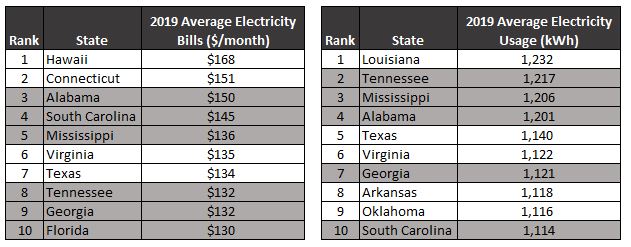Last month, October, the US Energy Information Administration (EIA) released another year of utility-reported electricity data. The latest annual data is for the calendar year of 2019.
Looking at the EIA’s tabulation of average usage and average bills by state, states in the Southeast once again top those two categories. This is not a distinction we want!

Utilities in the region tend to tout the fact that they provide electricity at low rates compared to other parts of the country. However, we’ve said before that customers pay bills and not rates, and the data shows the true picture: residents of the Southeast continue to pay some of the highest electric bills in the country and these high bills are driven, at least in part, by high usage.
To be clear, this is one piece of a much larger narrative of what drives household energy costs in different states. For instance, electric bills are not always the only energy cost that customers pay. But since residents in the Southeast are more likely to use electricity for home heating than other regions, state bill rankings can end up looking different when expenditures for direct fossil fuel use are included in total energy costs.
So what is to be done? One upside to the region’s status in these rankings is that lowering bills can largely be done under one proverbial roof since most energy efficiency programs, regardless of region, focus on electricity. Efforts to reduce electricity usage will bring down electricity bills across the region. These efforts can include the following.
- Utility-funded energy efficiency programs, which bring down usage and bills for participating customers, and also lower the utility’s overall costs and thus bills for all customers.
- Improvements to building codes by state, county, and municipal governments.
- Improvements to federal appliance standards, which increase the efficiency of the least efficient appliances available on the market.
Unfortunately, despite the potential to lower customer bills and utility costs, most major utilities in the Southeast lag far behind the rest of the nation in energy efficiency performance.
An added bonus of energy efficiency is that it also reduces the air and water pollution, including CO2 emissions, that occur with most of the electricity we use in the Southeast. We are working to simultaneously reduce overall electricity usage and also clean up electricity generation across the region. Sign up to follow our work and hear about advancements in these efforts.